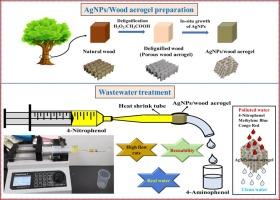Delignified wood aerogels functionalized with Ag nanoparticles for efficient catalytic reduction of 4-nitrophenol and dyes
IF 5.9
3区 工程技术
Q1 CHEMISTRY, MULTIDISCIPLINARY
Journal of Industrial and Engineering Chemistry
Pub Date : 2025-04-14
DOI:10.1016/j.jiec.2025.04.028
引用次数: 0
Abstract
Wood, a versatile, low-cost, and biodegradable material, holds great promise for water purification applications. However, its inherently low surface area and limited porosity present significant challenges. To overcome these limitations, we developed porous wood aerogels through delignification followed by in-situ functionalization with silver nanoparticles (AgNPs). The impact of delignification on crystallinity, surface functional groups, and morphology of the wood aerogels was thoroughly investigated and AgNPs preparation conditions were optimized using ICP-OES. Structural and chemical modifications were further analyzed using FTIR, XRD, XPS, and SEM, revealing preserved cellulose crystallinity and uniform AgNPs distribution. These AgNPs/wood aerogels demonstrated exceptional efficiency as filter materials, achieving over 90 % reduction of 4-nitrophenol at a flow rate of 2 mL/min, significantly outperforming non-delignified AgNPs/wood aerogels, which sustained only 0.5 mL/min. The aerogel also effectively degraded cationic (methylene blue) and anionic (Congo red) dyes, demonstrating its versatility for water treatment. Stability tests showed the material maintained over 90 % catalytic efficiency for 20 cycles without significant structural deterioration, as confirmed by post-reaction XRD, XPS, ICP-OES and SEM analyses. Applicability in real water samples was demonstrated using river, lake, and tap water, and a catalytic reduction mechanism was proposed.

用纳米银功能化的脱木质素木气凝胶高效催化还原4-硝基苯酚和染料
木材是一种用途广泛、成本低、可生物降解的材料,在水净化应用中具有很大的前景。然而,其固有的低表面积和有限的孔隙度带来了重大挑战。为了克服这些限制,我们通过脱木质素,然后用银纳米颗粒(AgNPs)原位功能化开发了多孔木材气凝胶。深入研究了脱木质素对木材气凝胶结晶度、表面官能团和形貌的影响,并利用ICP-OES优化了AgNPs的制备条件。利用FTIR、XRD、XPS和SEM等分析了纤维素的结构和化学修饰,揭示了纤维素的结晶度和AgNPs的均匀分布。这些AgNPs/木材气凝胶作为过滤材料表现出卓越的效率,在2 mL/min的流速下,4-硝基苯酚的去除率超过90%,显著优于非脱木质素AgNPs/木材气凝胶,后者的去除率仅为0.5 mL/min。气凝胶还能有效地降解阳离子(亚甲基蓝)和阴离子(刚果红)染料,证明其在水处理中的多功能性。稳定性测试表明,材料在20次循环中保持了90%以上的催化效率,并没有明显的结构劣化,反应后的XRD, XPS, ICP-OES和SEM分析证实了这一点。在河流、湖泊和自来水等实际水样中验证了其适用性,并提出了催化还原机理。
本文章由计算机程序翻译,如有差异,请以英文原文为准。
求助全文
约1分钟内获得全文
求助全文
来源期刊
CiteScore
10.40
自引率
6.60%
发文量
639
审稿时长
29 days
期刊介绍:
Journal of Industrial and Engineering Chemistry is published monthly in English by the Korean Society of Industrial and Engineering Chemistry. JIEC brings together multidisciplinary interests in one journal and is to disseminate information on all aspects of research and development in industrial and engineering chemistry. Contributions in the form of research articles, short communications, notes and reviews are considered for publication. The editors welcome original contributions that have not been and are not to be published elsewhere. Instruction to authors and a manuscript submissions form are printed at the end of each issue. Bulk reprints of individual articles can be ordered. This publication is partially supported by Korea Research Foundation and the Korean Federation of Science and Technology Societies.

 求助内容:
求助内容: 应助结果提醒方式:
应助结果提醒方式:


